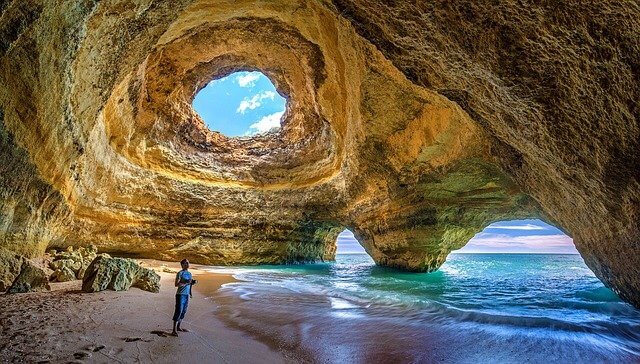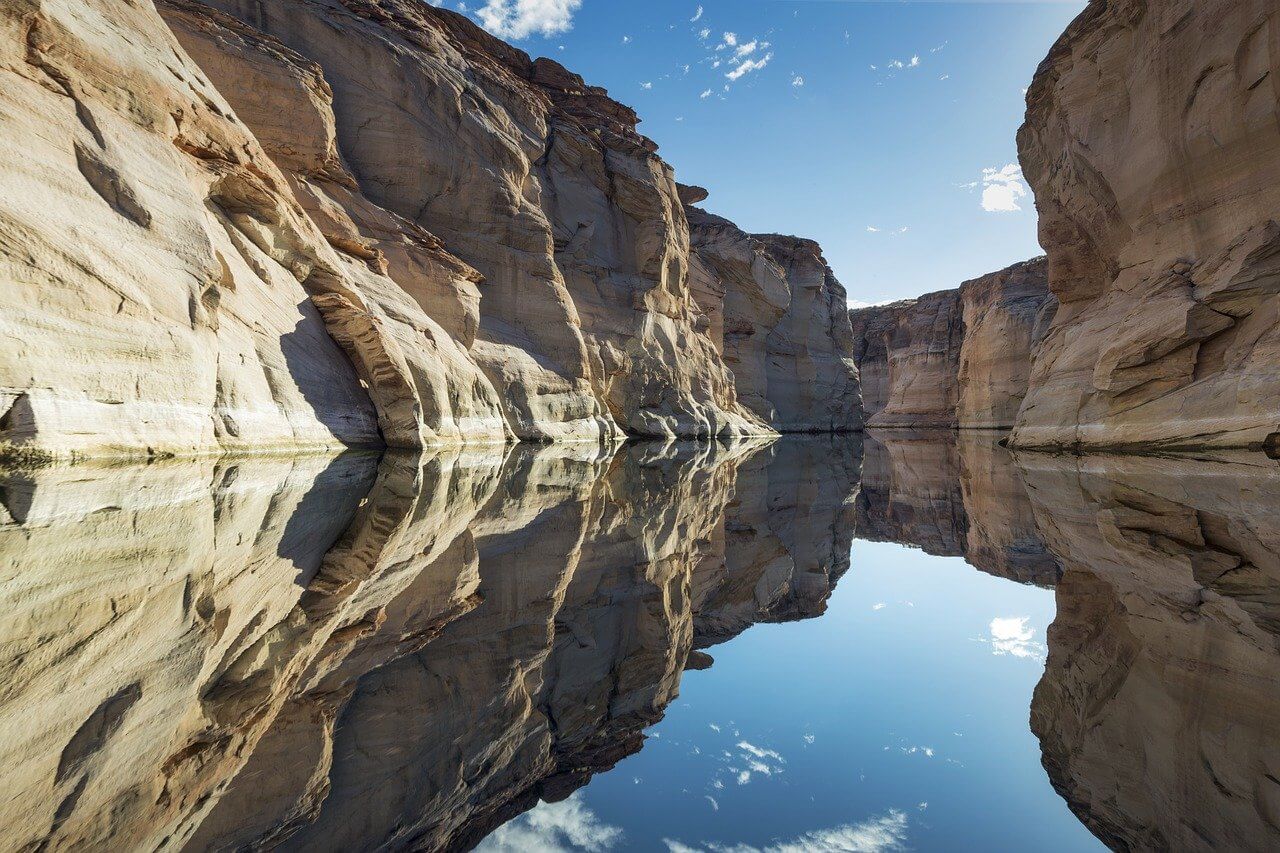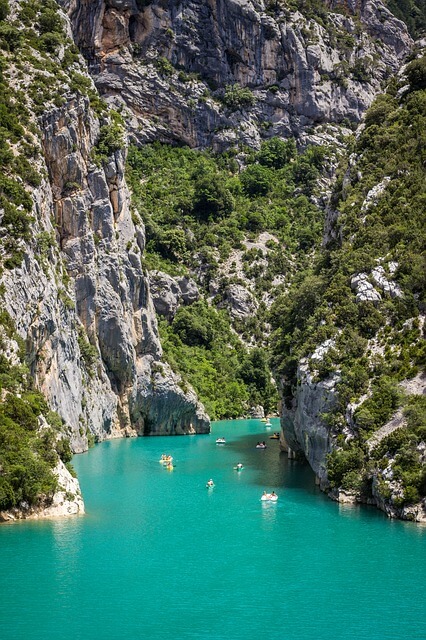What are the effects of moving water to change the Earth’s surface? How Does moving Water, River, Flood, Change The Earth’s Surface?
Because gravity makes water run downhill, water can move materials from one place to another. As water flows over the earth’s surface or within the earth, it carries materials from higher to lower places. Materials such as sand and clay are suspended in the water and carried in suspension. The amount of material and the size and weight of the pieces that water can carry depend on how fast the water is moving. The faster water moves, the more material and the larger and heavier the pieces it can carry. A stream flowing at a speed of 1/2 mile an hour can carry fine sand. But a stream flowing 3 miles an hour can roll stones the size of a hen’s egg. Rushing mountain torrents can move huge boulders.
Whenever water slows down, it drops part of the load that it has picked up. The materials settle to the bottom of the water as sediment. Water sorts the materials that it carries according to their size and weight. Large, heavy pieces can be carried only while the water is moving fast. As it begins to slow down, it drops the largest and heaviest pieces first. Then as it flows more slowly, it drops the smaller and lighter pieces a little farther along. Fine mud, or clay, will not settle until the water has been still for some time.
Water not only moves rocks and soil, but it also digs valleys. A valley begins as a narrow groove in the earth through which a little stream flows. If the water runs rapidly, the stream cuts deeper and deeper. As long as it is cutting deeper, the valley remains narrow with steep sides. Such a valley has a V shape and is called a young valley. After a time the stream stops cutting downward so rapidly. As the valley becomes more near level, the water flows more slowly. Then the stream begins to swing from side to side as it moves along. This cuts away the sides of the valley and widens its bottom, or floor. The valley now has a U shape and is called a mature valley.
Even though the valley has become mature, the water does not stop digging. The stream keeps on widening the valley until its sides have a very gentle slope. A wide valley with very gently sloping sides is called an old valley. The water in the stream now runs so slowly that it cannot carry much sand, clay, or other material. Of course, a young valley does not change into a mature one in a few years. Nor does a mature valley become an old one in just a short time. Erosion by moving water takes hundreds or even thousands of years to form valleys. All this time water flows over the land, wearing down rocks and soil and carrying them away.

Source : pixabay.com
During floods a stream overflows its banks.
In a mature valley or an old valley, the water spreads over the whole wide valley floor. The level space covered by water is called a flood plain. When the flood is over, the water flows slowly off the land. Then eroded materials such as clay and humus are left behind as sediment. Usually, flood plains are fertile farm land. From time to time they receive new deposits of soil that has been washed off higher ground. The flood plains of such rivers as the Nile in Egypt, the Ganges in India, and the Yangtze in China are noted for their rich land. Great centers of civilization have developed on each of these flood plains.
Most of the mud and sand carried by a stream never gets out on the flood plain. In old valleys, the water is often flowing so slowly that the eroded materials are deposited right in the stream bed. Where there are small obstructions in a river, the current is slowed down even more. So more soil settles here, and sand bars and mud bars begin to form around these small obstructions. When the river is low, trees and other plants grow on this soil. Their roots hold the soil in place. During floods more soil is deposited among the plants until large islands are formed. Mud Island, near Memphis, Tennessee, where the Wolf River flows into the Mississippi, was formed in this way. Islands like this are a great hindrance to the boats that carry freight and passengers up and down rivers.
The Mississippi River carries a huge load of sediment. Each year it transports some 400 million tons of soil and gravel downstream. About 90 per cent of it is in the form of fine particles suspended in water. The rest, mostly heavier material, is dragged or rolled along the bottom. Yet there has been no noticeable building up of its bed or valley lands for thousands of years. This is because the large amount of sediment that is carried is hardly noticed in the huge volume of water.
When a river reaches a lake or an ocean, the flow of its water is checked. Then its load of sand and mud settles to the bottom. If there are no strong currents to remove the sand and mud, it forms a delta, or fan-shaped area of new land that projects into the water. Many famous rivers have built deltas on which great cities have grown up surrounded by rich farm lands. One of these deltas is at the mouth of the Nile. Here stand the great cities of Cairo and Alexandria. At one time the long narrow arm of the Gulf of Mexico extended all the way to the mouth of the Ohio River.
Now the delta of the Mississippi River reaches more than 200 miles out into the Gulf of Mexico.
The Mississippi River is continuing to push its delta on outward at the rate of 340 feet each year. Yet the delta has not been built up. Instead, the earth’s crust has sunk under the weight of piled-up sediment.

Source : pixabay.com
Water cuts and carries away soil as the wind drives waves against the shores of oceans and lakes. The fine clay and humus remain suspended in the water for a long time and finally settle in quiet water. As the soil is carried away, sand and gravel are soon dropped to form beaches and sandbars along the shore. During storms the materials torn away by the waves may be piled up behind the beach in a ridge that later waves cannot reach. Along rocky shores, the waves drive loose rocks against each other and against the solid rock. In this way, the rock is gradually ground to pieces and carried away.
Besides carrying materials in suspension, moving water also carries materials in solution. Minerals from soil and rocks dissolve in rainwater, which flows away into nearby streams. The particles of a dissolved material are far too small to be seen, and they cannot be removed from water by filtering. So water that has been filtered through much sand and soil may look perfectly clear and yet be carrying dissolved minerals. The amount of minerals carried in solution at any time is usually small. But during a long period of years, water can dissolve and carry away large amounts.
Only a few minerals, such as salt, will dissolve in pure water. Most minerals will not dissolve in water alone, but they will dissolve in water that contains other materials in solution. As water seeps through the ground, it dissolves acids from plant roots and from decaying plant and animal materials. Then this water, with the acids dissolved in it, flows over rocks and combines with minerals in them to form new compounds. Some of these are dissolved and carried away.
For example, limestone is made almost entirely of calcium carbonate, which does not dissolve easily in pure water. When carbon dioxide dissolves in water, a weak acid called carbonic acid is formed. This acid changes calcium carbonate into another compound called calcium bicarbonate, which dissolves rather easily. When water with carbonic acid in it seeps down through tiny cracks in limestone, it begins to change and dissolve away the calcium carbonate. The opening in the rock gets larger and larger. An underground stream may form and carry away the dissolved rock until a cave is made.
Caves are usually formed only in regions where the rock underneath is limestone.
Through millions of years such great caverns as Mammoth Cave in Kentucky, Luray Caverns in Virginia, and Carlsbad Caverns in New Mexico have been produced. Sometimes water, with its carbonic acid, dissolves out a funnel-shaped pit in the rock. Or the roof of a cave falls in. The soil above these holes settles, and a low place in the ground is formed. Such a place is called a sinkhole.
The dissolved material that is carried by water can be deposited only when the water evaporates or some chemical change occurs. Water seeping through the limestone of a cave comes out on the ceiling in drops. Some of the dissolved carbon dioxide gas in the water escapes into the air of the cave. Then the water can no longer keep the calcium compounds in solution. Each drop leaves a little deposit on the ceiling or on the floor of the cave. In time, layers of these deposits build unusual rock formations. Icicle-like forms that hang down from the ceiling are called stalactites. Where the water drips onto the floor of a cave, cones called stalagmites are built up. When a stalactite and a stalagmite meet one another, a column is formed. Some water runs down the sides of a cave, and layers of stone also form there.
Most minerals in solution are carried into streams and finally into the ocean. Some minerals are carried into lakes and seas that have no outlet. Water in these large bodies is constantly evaporating. But the minerals cannot evaporate, and so they are left behind. As more and more water brings in its load of minerals, the solution becomes stronger and stronger. Through chemical action, some of the minerals change to solids and settle to the bottom. Others are used by sea animals to build their skeletons and shells.

Source : pixabay.com
Common salt and some other minerals remain in water. For example, the Great Salt Lake in Utah has no outlet. Such large amounts of minerals have been deposited in the Great Salt Lake that one fifth of the liquid is salt and other dissolved minerals. If a great body of salt water dries up completely, the salt and any other minerals that are in the water are left on the bottom. Rock salt is believed to have been formed in some such way through the repeated filling and evaporation of a body of salt water. A deposit of rock salt more than 2000 feet thick is found in Louisiana.